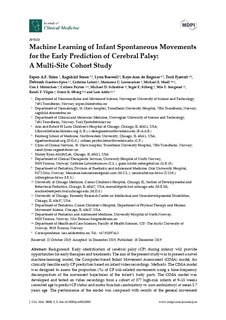| dc.contributor.author | Ihlen, Espen Alexander F. | |
| dc.contributor.author | Støen, Ragnhild | |
| dc.contributor.author | Boswell, Lynn | |
| dc.contributor.author | de-Regnier, Raye-Ann | |
| dc.contributor.author | Fjørtoft, Toril Larsson | |
| dc.contributor.author | Gaebler-spira, Deborah | |
| dc.contributor.author | Labori, Cathrine | |
| dc.contributor.author | Loennecken, Marianne | |
| dc.contributor.author | Msall, Me | |
| dc.contributor.author | Møinicken, Unn inger | |
| dc.contributor.author | Peyton, Colleen | |
| dc.contributor.author | Schreiber, Me | |
| dc.contributor.author | Silberg, Inger Elisabeth | |
| dc.contributor.author | Songstad, Nils Thomas | |
| dc.contributor.author | Vaagen, Randi | |
| dc.contributor.author | Øberg, Gunn Kristin | |
| dc.contributor.author | Adde, Lars | |
| dc.date.accessioned | 2020-01-13T10:47:57Z | |
| dc.date.available | 2020-01-13T10:47:57Z | |
| dc.date.created | 2020-01-06T15:21:16Z | |
| dc.date.issued | 2019 | |
| dc.identifier.issn | 2077-0383 | |
| dc.identifier.uri | http://hdl.handle.net/11250/2635922 | |
| dc.description.abstract | Background: Early identification of cerebral palsy (CP) during infancy will provide opportunities for early therapies and treatments. The aim of the present study was to present a novel machine-learning model, the Computer-based Infant Movement Assessment (CIMA) model, for clinically feasible early CP prediction based on infant video recordings. Methods: The CIMA model was designed to assess the proportion (%) of CP risk-related movements using a time–frequency decomposition of the movement trajectories of the infant’s body parts. The CIMA model was developed and tested on video recordings from a cohort of 377 high-risk infants at 9–15 weeks corrected age to predict CP status and motor function (ambulatory vs. non-ambulatory) at mean 3.7 years age. The performance of the model was compared with results of the general movement assessment (GMA) and neonatal imaging. Results: The CIMA model had sensitivity (92.7%) and specificity (81.6%), which was comparable to observational GMA or neonatal cerebral imaging for the prediction of CP. Infants later found to have non-ambulatory CP had significantly more CP risk-related movements (median: 92.8%, p = 0.02) compared with those with ambulatory CP (median: 72.7%). Conclusion: The CIMA model may be a clinically feasible alternative to observational GMA. | nb_NO |
| dc.language.iso | eng | nb_NO |
| dc.publisher | MDPI | nb_NO |
| dc.rights | Navngivelse 4.0 Internasjonal | * |
| dc.rights.uri | http://creativecommons.org/licenses/by/4.0/deed.no | * |
| dc.title | Machine Learning of Infant Spontaneous Movements for the Early Prediction of Cerebral Palsy: A Multi-Site Cohort Study | nb_NO |
| dc.type | Journal article | nb_NO |
| dc.type | Peer reviewed | nb_NO |
| dc.description.version | publishedVersion | nb_NO |
| dc.source.journal | Journal of Clinical Medicine | nb_NO |
| dc.identifier.doi | 10.3390/jcm9010005 | |
| dc.identifier.cristin | 1767090 | |
| dc.description.localcode | © 2019 by the authors. Licensee MDPI, Basel, Switzerland. This article is an open access article distributed under the terms and conditions of the Creative Commons Attribution (CC BY) license (http://creativecommons.org/licenses/by/4.0/). | nb_NO |
| cristin.unitcode | 194,65,30,0 | |
| cristin.unitcode | 194,65,15,0 | |
| cristin.unitname | Institutt for nevromedisin og bevegelsesvitenskap | |
| cristin.unitname | Institutt for klinisk og molekylær medisin | |
| cristin.ispublished | true | |
| cristin.fulltext | original | |
| cristin.qualitycode | 1 | |

